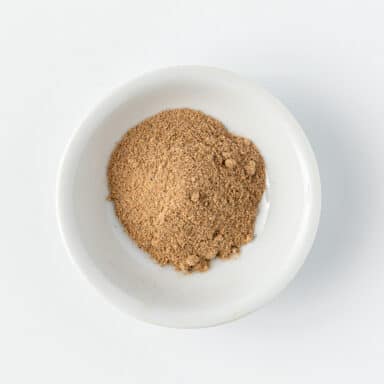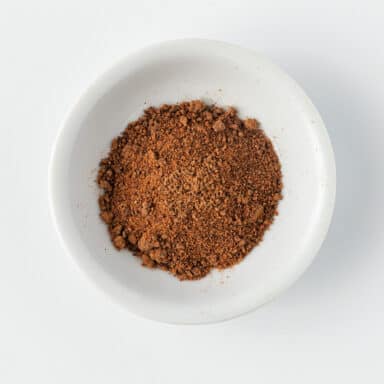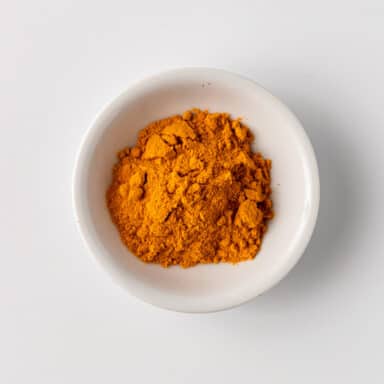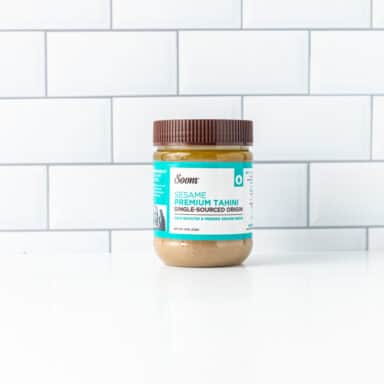This list of Mediterranean spices, herbs and pantry staples are the essentials you’ll need for making your favorite recipes at home!

When you’re new to cooking Mediterranean food and you find a recipe that you want to make, it can be difficult to find a local source for some of the ingredients. In addition to that, you may not even know what some of those ingredients are, or how to use them.
If you can relate, this resource is definitely for you! Bookmark this page and refer to it whenever you need information on specific Mediterranean spices, herbs, or pantry essentials.
Countries considered Mediterranean (as having have coastlines on the Mediterranean Sea) include Albania, Algeria, Bosnia and Herzegovina, Croatia, Cyprus, Egypt, France, Greece, Israel, Italy, Lebanon, Libya, Malta, Monaco, Montenegro, Morocco, Slovenia, Spain, Syria, Tunisia, and Turkey.
How to Convert Whole Spices to Ground Measurements
Allspice: 1 teaspoon allspice berries = 1 teaspoon ground allspice
Black pepper: 1 teaspoon peppercorns = 3/4 teaspoon ground pepper
Cardamom: Approximately 12 pods, dehusked = 1 teaspoon ground cardamom
Cinnamon: One 1 1/2-inch (4-centimeter) stick = 1 teaspoon ground cinnamon powder
Coriander seeds: 1 teaspoon coriander seeds = 3/4 teaspoon ground coriander
Cumin: 1 teaspoon cumin seeds = 1 teaspoons ground cumin
Fennel: 1 teaspoon fennel seeds = 1 teaspoon ground fennel
Mustard seeds: 1 teaspoon mustard seeds = 3/4 tsp ground mustard
Nutmeg: 1/2 nutmeg = 1 teaspoon ground nutmeg
To use ground spice instead of whole spice, the most straightforward conversion is to use about three-quarters as much ground as you would whole. If a recipe calls for a teaspoon of whole coriander, use ¾ teaspoon of ground coriander. There are, of course, factors to take into consideration.
Ball-shaped spices, like round peppercorns or coriander seed, don’t sit neatly in a stack in your measuring spoon. There are pockets of space between them. If you were to break them up, they would take up much less space, hence the idea of ¾ teaspoon ground spice for each teaspoon whole.
Smaller spices, like cumin or caraway, lay much more neatly together in a measuring spoon, so there is less space between the seeds. These spices come closer to a 1:1 ratio.
Source: spiceinc
NOTE: Whenever possible, we also include links to online sources where you can buy the ingredients. Some of them are Amazon affiliate links. This means, there is no difference in your cost to buy them, but we receive a small commission for your purchase. This helps us to keep creating recipes for you to make, so thank you for your support! For more information, see our privacy policy.
(data sources: lots of research, taste testing and from a few favorite sites The Spice House, Bon Appetit, Seasoned Pioneers and the Kitchn)
Dried vs Canned Beans
Typically if a recipe calls for 1 cup dried chickpeas, which are soaked overnight and cooked, you can easily substitute 2 – 15 ounce cans of chickpeas (garbanzo beans).
Mediterranean Spices
Ground Allspice
Allspice is the dried brown berry of the tropical Pimenta dioica tree, a clove relative native to the West Indies and Central America.
It got its name in the 17th century, when allspice berries were first imported to Europe, since it’s said to taste like a combination of clove, cinnamon, and nutmeg.

Dried Bay Leaves
Bay leaves are a fragrant leaf from the laurel tree used as an herb. Bay leaves are available whole—either fresh or dried—or ground into a powder. The leaves are added to slow-cooked recipes, such as soups, sauces, and stews, and are removed before serving the dish.
They have a floral and herbal scent reminiscent of oregano and thyme and are used more often than any other herb.

Ground Cardamom
Whether whole green pods, black seeds or ground, cardamom is the staple spice in making savory dishes, sweets and drinks. A pinch of this hot and pungent spice elevates every dish to a super mesmerizing level.
For its appealing aroma, cardamom is usually the main flavoring ingredient.

Cayenne Pepper
Cayenne pepper is a super spicy chili that rates high on the Scoville scale—a method for measuring peppers’ heat levels. Cayenne is earthy and spicy, whereas paprika can range from earthy and spicy to mild and sweet.
Ground paprika is produced by grinding numerous peppers and can have a flavor ranging from sweet to fiery.

Coriander (Whole or Ground)
This versatile spice has a hint of citrus and adds earthy notes to dishes. The whole seeds are lightly toasted and then ground with other spices for several popular spice blends.
Ground coriander is popular because it adds texture to dishes and can be tasted with each bite. Coriander is often paired with cumin for just the right flavors of earthiness.

Ground Cumin
The first notes of cumin are sharp, zesty, and bitter, similar to fresh parsley or carrot skin. The base notes of cumin are pungent, earthy, and nutty. Cumin is often described as a warming spice, but if you crush a whole seed between your teeth you will also notice a slight menthol quality akin to fennel seed or caraway.
Caraway and cumin are often mistaken for one another due to their similar appearance and taste.

Dill (Fresh or Dried)
Dill tastes grassy with a bit of anise-like licorice flavor. Be aware that once the weather turns hot, dill plants flower or “bolt.” This bolting changes the flavor of the leaves, making them less aromatic and more bitter. Dill seed tastes like a mild version of caraway.

Ground Nutmeg
Nutty and slightly sweet, nutmeg is an intense spice that has a strong and distinct aroma. For those who are more sensitive to heat, nutmeg might seem almost spicy.

Oregano
The aroma of oregano has a camphor note. The taste is pungent and described as earthy and green with some mint and hay. It can be slightly bitter. Oregano is easily confused with its close relative, marjoram.
In the Mediterranean, oregano is also known as wild marjoram, but that doesn’t mean it is marjoram. Oregano is a familiar herb that many people know from dishes such as pizza and pasta sauce.
One of the most widely-used herbs worldwide, it is found in Mediterranean and Mexican cuisine and is even one of the components of chili powder.

Rosemary (Fresh or Dried)
Rosemary is a bush with fragrant, evergreen, needle-like leaves and white, pink, purple, or blue flowers that is native to the Mediterranean region.
This woodsy aromatic herb has notes of evergreen, citrus, lavender, pine, sage, pepper, mint, and sage.

Paprika
Paprika is a universal seasoning and a ubiquitous item in the spice cabinet. It is made of a combination of dried peppers from the Capsicum annum family, which include both sweet and hot peppers. This striking, crimson-red colored powder is very versatile.
Most paprika comes from Hungary and Spain and is either sweet, hot, or smokey. The type of pepper used, where it comes from, and how it is prepared determines the flavor.
Depending on the type of paprika, it can range from mild and sweet to spicy to smoked. The heat factor has to do with how the red powders are produced.

Sumac
The brick-red finely ground berries of the sumac shrub give an astringent, lemony brightness to whatever they touch. It is used a great deal in Arabic cooking as a souring agent for meats, stews and dressings.
This is fantastic sprinkled over hummus or grilled meats.

Turmeric
Turmeric is a bright yellow spice powder that is made from the root of a plant in the ginger family. Flavor-wise, it is overwhelmingly earthy and bitter, almost musky, with a bit of peppery spice that has a hint of mustard or horseradish.
It’s not a particularly distinct or pleasant taste. Cooks say that it brings out the overall flavors of the dishes it is added to, as well as giving them a yellow color.

Zaatar
A highly versatile, herbal mix of spices including toasted sesame seeds, sumac and thyme. It is known to have an herbal, citrus, nutty flavor. The spice mix is used for roasting poultry, fish and vegetables. It can season eggs, grains and salads or flavor marinades, dips and dressings. I make my own zaatar spice blend, give it a try!
Throughout the Middle East, Zaatar is enjoyed with bread but Arabic regions use the spice mix differently. Some mix with oil and spread over flatbreads, while others add it to the dough and bake.
Said to have its origins in ancient Egypt, Zaatar is also extremely popular in Palestine, Syria, Lebanon, Jordan and Turkey. Depending on the region, the mix takes on slightly different forms.
In Palestine, they include caraway seeds and dried thyme leaves and the mix has a brighter green color. In Lebanon, they include sumac, which gives it a deep reddish color. In Syria, they use a combination of dried ground thyme and sumac, which gives it a brownish coloration.

Condiments
Olive Oil (EVO – Extra Virgin Olive oil)
Olive oil is made by pressing fresh olives to extract the oil. It’s a popular cooking oil that is produced in olive-growing regions, most often France, Italy, Spain, Greece, and California.
Its flavor is highly prized and used often in Mediterranean and European cuisines. Considered one of the healthier fats, it has also found a place in kitchens around the world, appearing in cold applications like salad dressing and pasta and used for frying, sautéing, and baking.

Tahini
A paste made from ground sesame seeds, it’s often blended into classic dips, such as hummus and baba ghanoush. Tahini-based sauces appear widely in Armenian, Turkish, Iraqi, Cypriot, Greek, East Asian, and Indian.
Grinding sesame seeds turns them into a thick, oily paste similar in texture to natural peanut butter. Essentially sesame seed butter, tahini adds a nutty flavor and creamy texture to recipes ranging from savory to sweet.
It has the earthy, nutty flavor of sesame seeds but with a tinge of bitterness (although if it tastes unpleasant or astringent, it’s past its prime).
My favorite brand is made from Ethiopian sesame seeds. It can be served by itself and is a major ingredient in hummus, Mutubal, baba ghanoush, and halva. Tahini is used in the cuisines of the Levant and Eastern Mediterranean, the South Caucasus, as well as parts of Northern Africa.

Tomato Passata/Sauce
Passata is an uncooked tomato purée that has been strained of seeds and skins. It originated in Italy but is used throughout Europe. Some passatas are chunkier and some are smoother, depending on the brand.
Some people claim that passata can also be cooked, but most agree that it is uncooked. You will also see it spelled passato and passata di pomodoro, and it can also simply be called “strained tomatoes.” Tomato sauce and tomato paste are cooked products, which instantly makes them different from passata.
In addition, tomato sauce often has other ingredients such as carrots, onions, and garlic, while tomato paste is cooked down to be extra concentrated and thick.

Vinegars, syrups, and wines
White Vinegar
Taste-wise, white vinegar is the sharpest stuff around, so being careful when you’re cooking with it is important. White vinegar is comprised of acetic acid (about 5-10%) and water (about 90-95%), which yields a vinegar with an incredibly clean, crisp, strong taste.
When it comes to marinades, you can use white vinegar only if you’re working with a recipe that calls for a lot of sugar. The aggressive acid from the vinegar needs to be balanced by sweetness.

Balsamic Vinegar
Balsamic vinegar has been produced in and around its birthplace, the city of Modena, in the northern region of Emilia-Romagna, Italy, for nearly a thousand years. This is a wine-producing area, specializing in trebbiano (white) and lambrusco (red) grape varieties, and it was the tradition to set aside some of the must—the unfermented juice of grapes—to make a very special vinegar.
The juice is slowly cooked down to the consistency of a syrup, concentrating its flavors and aromas, and darkening its color. It is then cooled and transferred to wooden barrels, where the cooked must undergoes a slow fermentation, creating alcohol which, in turn, is attacked by acetic bacteria, turning the wine into vinegar.
This is followed by a very lengthy aging process of 12 years or more. During this time, as the liquid in the barrel evaporates, the contents are transferred to smaller and smaller barrels of different types of wood, such as chestnut, cherrywood, ash, mulberry, and juniper.
After that, the vinegar may be aged for an additional period of time before bottling.

Balsamic Syrup
This is balsamic vinegar that has been slowly reduced and thickened over time and or heat with an intensified flavor.

Dry White Wine
A Sauvignon Blanc, Chardonnay, Muscadet, Pinot Gris / Pinot Grigio and a Riesling are choices.

Dry Red Wine
Cabernet Sauvignon, Merlot, Pinot Noir, Shiraz/Syrah, Zinfandel, Sangiovese, and Cabernet Franc are good choices.








